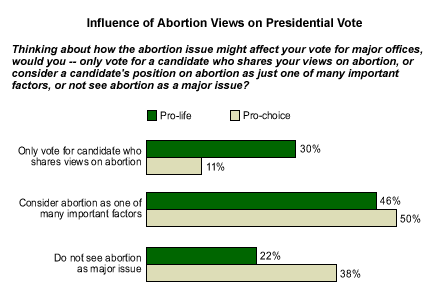Abortion, though not the most talked-about subject this presidential election, may be an important stealth issue that could impact the outcome in key states, or even nationally. Most Americans have moderate views on abortion and are focused on other concerns. But there is a segment of voters on either side of the abortion debate -- representing 19% of likely voters -- who claim that the issue completely directs which candidates they are willing to support. Maximizing turnout among these voters is certain to be an important part of both candidates' Election Day strategies.
"Pro-Life" Voters Have Electoral Edge
By a 52% to 41% margin, Americans are more likely to identify as "pro-choice" than as "pro-life," which would seem to bode well for Democratic candidate John Kerry's chances of capitalizing on the issue. However, pro-life voters may have the greater impact at the polls. The reason lies in their level of intensity.
A recent CNN/USA Today/Gallup poll* shows that self-identified pro-life Americans are nearly three times as likely as pro-choice Americans to describe themselves as single-issue voters on abortion. Thirty percent of pro-lifers say they will only vote for a candidate who shares their views on abortion. This contrasts with only 11% of pro-choicers who say they will only back candidates of a similar mind on abortion.

The net result is that 13% of all likely voters say they are pro-life and will only vote for a candidate who shares their views on abortion. Naturally, most of these (90%) are voting for George Bush. By contrast, only 6% of the electorate will vote strictly pro-choice, and virtually all of these people are voting for Kerry. The remaining voters are divided between those who say abortion will be one of many important issues they consider (48% of the voting public), and those who say abortion is not a major factor for them (32%).
These results are not unique to this election. Gallup found a similar pattern in 2000, and the national exit polling in every presidential election since 1984 has shown a net advantage to the pro-life side over the pro-choice side, based on the percentage of single-issue abortion voters in the electorate.
Bush Depends More on the Issue
The importance of the pro-life position to Bush's base of support this year is clear. Nearly a quarter of his voters (23%) are single-issue pro-life voters. Take them away and Bush's lead in the national horse race would disappear. Only 13% of Kerry's supporters are single-issue pro-choice voters. But in a close election, activating these votes could be important to his candidacy also.
Bottom Line
The presidential candidates freely talk about their plans to improve the economy, keep taxes down, and provide flu vaccines; issues such as these pose little risk of offending anyone. But on abortion (as with gay marriage and other cultural hot buttons), speaking in frank terms to the electorate about their positions risks activating the opposition as much as energizing each candidate's own base. Neither Bush nor Kerry flaunts his stance on abortion on the front page of his Web site or in his stump speeches.
Nevertheless, given the current state of abortion attitudes, Bush, in particular, has good reason to hold firm to his pro-life position and to communicate his views to the pro-life voters who stand ready to give him a second term. Kerry also has every reason to do the same with pro-choice voters. Chances are that they are doing this, but discreetly -- through targeted mail and paid advertising in selective regions.
*Results are based on telephone interviews with 1,013 national adults, aged 18 and older, conducted Oct. 14-16, 2004. For results based on the total sample of national adults, one can say with 95% confidence that the maximum margin of sampling error is ±3 percentage points.
Results based on likely voters are based on the subsample of 788 survey respondents deemed most likely to vote in the November 2004 general election, according to a series of questions measuring current voting intentions and past voting behavior. For results based on the total sample of likely voters, one can say with 95% confidence that the margin of sampling error is ±4 percentage points. The likely voter model assumes a turnout of 55% of national adults. The likely voter sample is weighted down to match this assumption.
In addition to sampling error, question wording and practical difficulties in conducting surveys can introduce error or bias into the findings of public opinion polls.
